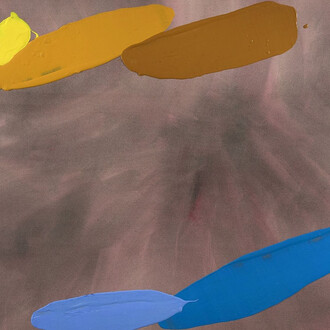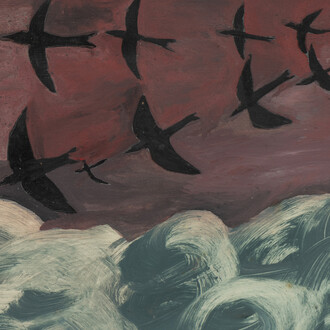Gaa is pleased to present In the state of decision, Kasia Fudakowski’s first solo exhibition with the gallery and debut solo exhibition in the United States. The exhibition’s visitor activated sculptures and changeable lighting, explore the relationship between big and small decisions and the process of making them. Fudakowski’s works refer to the allure and danger of binary categorisation and the subsequent absurdity that it unfolds in our political and social climate, revealing the discrepancies amongst cultural norms.
Dear Visitor,
Can you read this? Is it bright enough? Which way did you flip the switch? We value our freedom to make decisions but aren’t we welding our own consequential cages by making them? Wouldn’t we sometimes prefer to remain in the state where all those decisions live that were not made or even better: not not made?
According to the philosopher Peter Sloterdijk our problem is that we are unterergriffen (undercaptivated) and überbefreit (overliberated), which he explains using the example of romantic partner choice: to meet someone depends on coincidence but once we have settled on (and with) a person we have a hard time not thinking of this encounter as meant to be. This contingency-necessity-dilemma seems impossible to avoid unless we put down our rose-coloured glasses and accept the concept of mere probability, this economy-teacher’s pet that has managed to convince neither lovers nor the philosophically inclined in the smoker’s corners of the campuses.
Kasia Fudakowski (no stranger to the power and possibility of repetition, who successfully quit smoking several times) deals with this dilemma acrobatically. If the task is “to jump from contingency and land in necessity” (Sloterdijk) she directs our attention to the pirouettes we perform mid-air. In free fall, mastery is the control of our lack of control, and weird elegance trumps desperate weirdness. And weirdly elegant they are, these pivoting loose-limbed cut outs that scramble the air moved by the chaotic mechanics of a double pendulum. No complete choreography is ever replicated since too many natural laws are pulling the strings here, and if it weren’t for friction (that old bore) they would dance and gesticulate forever. Some decisions are simply made for us by time, friction and gravity, while our part is to dance along as gracefully as possible. These mechanical machines are running an indecision game that has never heard of Alan Turing’s “convenient fiction” of binary states, even if the brightest minds won’t stop going on about it. Fudakowski maintains a convenient fiction of her own: an innocent mistake, which is deliberately repeated, is not a mistake anymore. This seems to be the reverse of the double negativity of not not making a decision: a double positivity that together with the not-not creates a syntactical rhythm that is flickering through the exhibition.
By passing into the state of indecision we run the risk of getting entangled in the twigs of decision trees that bifurcate into peculiar shapes. Which type of logic blossoms into the pros and cons of sharing two double beds with your partner or an ice cream with a child? The particular outgrows the universal high and low, which is why the crucial information is sometimes to be sought in the thicket or at the fringes, not on the main roads. Fudakowski present us with a reasoning that is not decision-making. And yet, by its own logic, is not not decision-making. But which one is it? You decide.
Marie von Heyl is a Berlin based artist, writer and philosopher who works with and on subject-object relations, the productive inadequacies of language and the creative process as a libidinal practice.
Kasia Fudakowksi (b. 1985) is a visual artist whose diverse and playful practice, which includes sculpture, film, performance, and writing, explores social riddles through material encounters, surreal logic and comic theory. Often referring to the allure and danger of binary categorisation and the subsequent absurdity that it unfolds in our political and social climate, her work reveals the discrepancies amongst cultural norms. Where she employs comic mechanisms, the tragic is never far behind, so that her work often hovers between the horrific and the comic. Frequently the target of her own attacks, she explores her own role as an artist and the stereotype thereof with both a seriousness and irreverence typical of her approach.
Fudakowski studied at the Ruskin School of Drawing and Fine Art, Oxford University, graduating in 2006 before moving to Berlin. Her work has been exhibited internationally at the 25th Biennial in Gabrovo, Bulgaria; Kunsthalle Hamburg, Germany; Künstlerhaus Bremen, Germany; Palazzo Grassi – Punta della Dogana, Venice, Italy; Museum Ludwig, Cologne, Germany; Sprengel Museum, Hannover, Germany; LOKremise – Kunstmuseum, St.Gallen, Switzerland; Deutsches Hygiene Museum, Dresden, Germany; 15th Istanbul Biennial, Turkey; SALTS, Basel, Switzerland; Kunstverein Braunschweig, Germany; Kunstverein für die Rheinlande und Westfalen, Düsseldorf, Germany; Museo Marino Marini, Florence, Italy; 1646, The Hague, Futura Centre for Contemporary Art, Prague; Max Pechstein Museum, Zwickau, Germany; GAK Gesellschaft für Aktuelle Kunst, Bremen, Germany; Museum of Contemporary Art, San Diego; and the Künstlerhaus Bethanien, Berlin, Germany. Fudakowski lives and works in Berlin.
















